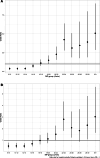Mechanical Power Is Associated With Mortality in Pressure-Controlled Ventilated Patients: A Dutch, Single-Center Cohort Study
- PMID: 39699550
- PMCID: PMC11661764
- DOI: 10.1097/CCE.0000000000001190
Mechanical Power Is Associated With Mortality in Pressure-Controlled Ventilated Patients: A Dutch, Single-Center Cohort Study
Abstract
Importance: Mechanical power (MP) could serve as a valuable parameter in clinical practice to estimate the likelihood of adverse outcomes. However, the safety thresholds for MP in mechanical ventilation remain underexplored and contentious.
Objectives: This study aims to investigate the association between MP and hospital mortality across varying degrees of lung disease severity, classified by Pao2/Fio2 ratios.
Design, setting, and participants: This is a retrospective cohort study using automatically extracted data. Patients admitted to the ICU of a tertiary referral hospital in The Netherlands between 2018 and 2024 and ventilated in pressure-controlled mode were included.
Main outcomes and measures: Logistic regression, adjusted for age, sex, Acute Physiology and Chronic Health Evaluation-IV score, and Pao2/Fio2 ratio, was used to calculate the odds ratio (OR) for all-cause in-hospital mortality.
Results: A total of 2184 patients were analyzed, with a mean age of 62.5 ± 13.8 years, of whom 1508 (70.2%) were male. The mean MP was highest in patients with the lowest Pao2/Fio2 ratios (21.5 ± 6.5 J/min) compared with those with the highest ratios (12.0 ± 3.8 J/min; p < 0.001). Adjusted analyses revealed that increased MP was associated with higher mortality (OR, 1.06; 95% CI, 1.03-1.09 per J/min increase). Similarly, MP normalized for body weight showed a stronger association with mortality (OR, 1.004; 95% CI, 1.002-1.006 per J/min/kg increase). An increase in mortality was seen when MP exceeded 16-18 J/min.
Conclusions and relevance: Our findings demonstrate a significant association between MP and hospital mortality, even after adjusting for key confounders. Mortality increases notably when MP exceeds 16-18 J/min. Normalized MP presents an even stronger association with mortality. These results underscore the need for further research into ventilation strategies that consider MP adjustments.
Copyright © 2024 The Authors. Published by Wolters Kluwer Health, Inc. on behalf of the Society of Critical Care Medicine.
Conflict of interest statement
The authors have disclosed that they do not have any potential conflicts of interest.
Figures



References
-
- Gattinoni L, Carlesso E, Cadringher P, et al. : Physical and biological triggers of ventilator-induced lung injury and its prevention. Eur Respir J Suppl 2003; 47:15s–25s - PubMed
MeSH terms
LinkOut - more resources
Full Text Sources

